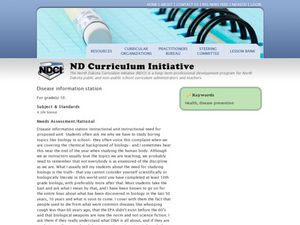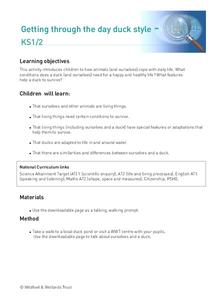Curated OER
Mushrooms Can Save the World
Students use mushrooms to solve problems. In this environmental activity, students study how fungi have been used to combat environmental problems. Students design strategies that employ mushrooms to combat other environmental challenges.
Curated OER
Crafty Cuttings
Students learn how to successfully plant a cutting. In this plant cutting lesson, students understand the steps of making a plant cutting and can explain them to others.
Curated OER
Chemical or Physical Change?
Eighth graders participate in several science activities to note chemical or physical changes after discussion. They understand that all matter has definite structure which determines physical and chemical properties.
Curated OER
Heredity, Genetics, Traits
Eighth graders study how an embryo develops into a fetus by undergoing many physical changes which they observe on a poster. They examine the metamorphosis of fruit flies as they develop through a series of changes. They record the...
Curated OER
The Bulbs: Camas and Daffodil
Fourth graders become aware of the importance of the camas bulb to the Nez Perce people, they learn the parts of plants, and gain understanding of the interdependence of Nature. They study about the possible causes and outcomes of global...
Curated OER
Natural Selection I
Eighth graders list the steps of Darwin's natural selection. They demonstrate the process of natural selection in a predation activity. Students create paper origami frogs to race across the floor and analyze the differences in the...
Curated OER
Velocity and Acceleration
Twelfth graders look at local speed limits and traffic controls and see if they are reasonable. They plot the displacement and time to represent velocity, develop a plan for improving the current system, and organize experimental...
Curated OER
Disease Information Station
Tenth graders study disease and how it changes normal body functions. In this research lesson students research a disease and use a word processing software to construct a presentation.
Curated OER
2D Concept Visualization: Cell Organelles Presentation
Students create simple 2D concept driven visualizations of cells and cell organelles and organize them into an effective presentation.
Curated OER
A Taste of Blackberries
Fourth graders participate in a shared reading of Doris Buchanan's, A Taste of Blackberries. They read about grief in the loss of a best friend and examine the skills of a responsible family member.
Curated OER
Ethics Search Project
Students question, imagine, and investigate certain scientific environmental issues. They organize their data and present a PowerPoint presentation. They include include a complete analysis of St Ignatius commitments and ideas.
Curated OER
Volcanoes In Japan
Sixth graders study the characteristics of volcanoes in this unit. They apply the research to the study of three volcanoes in Japan. They complete mapwork, identify indicators of impending volcanic activity, and describe the dangers...
Curated OER
Celebrating 100 Years of Flight
Young scholars practice reading comprehension, note taking and writing skills. In this literacy and writing lesson, students read about the invention of airplanes, women pilots and the space race before writing their own news article on...
Curated OER
Classifying Polygons
Students study polygons. In this math lesson, students play a game in which they learn the classification system for polygons. Students identify the properties of quadrilaterals.
Curated OER
The Effects of Water Quality on the Growth Rate of Freshwater Mussels
Students participate in a field and laboratory study to determine if local freshwater mussels are environmentally stressed.
Curated OER
Investigation 5 - Balloon Rockets
Third graders make a ballon rocket to study the relationship between the force applied to an object and the resulting motion.
Curated OER
Waddle You Know About Penguins
Second graders study the similarities and differences of the seventeen species of penguins. They investigate habitats and how these habitats are suited to each species characteristics. They see how animals adapt to their environments.
Curated OER
Diversity And Adaptations Of Organisms
Eighth graders study how and why animals are classified into eight groups in the animal kingdom. They work together to identify organisms. They use the key to determine the phylum for the included problems.
Curated OER
Parent and Baby Lookalikes
Learners research baby animals, their special names and the vocabulary to describe their relative sizes through discussion, listening to a Salish story, looking at pictures, and creative artwork . They will also explore the significance...
Curated OER
Ecosystems: Biotic and Abiotic Factors
Seventh graders examine proper journaling techniques, and record observations about at tree after listening to a read aloud of "Four Worlds: The Dine Story of Creation." They study the difference between living and non-living things, and...
Curated OER
Getting through the day duck style
Students are introduced to how animals (and ourselves) cope with daily life. They discover that living things need certain conditions to survive. Students investigate how living things (including ourselves and a duck) have special...
Curated OER
Genetics
Students explain the difference between dominant and recessive genes, identify what causes differences in the traits of parents and their offspring, and explain how sex is determined. They will also improve their reading and...
Curated OER
Earth Science: In Depth Look at Earthquakes
Students engage in an interactive Internet lesson covering the reasons and results of earthquakes. After reading eyewitness accounts and viewing animations, they use seismograms to measure and locate the epicenters. In an ongoing study,...
Curated OER
Using the Very, Very Simple Climate Model in the Classroom
Students study the relationship between the average global temperature and carbon dioxide emissions. In this weather lesson students develop a test scenario using a model then read and interpret graphs of data.

























